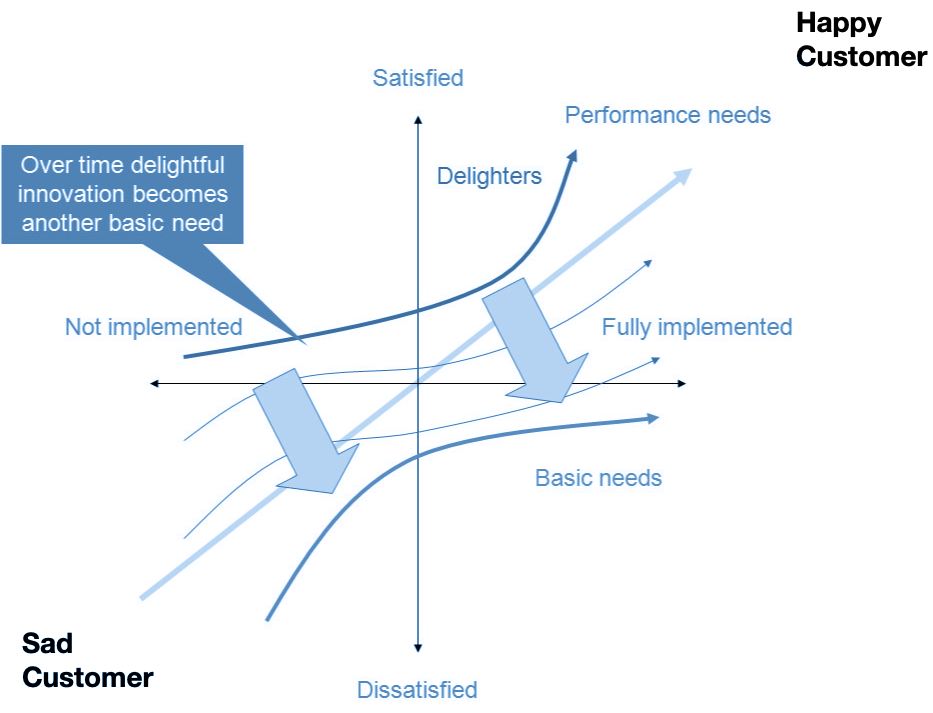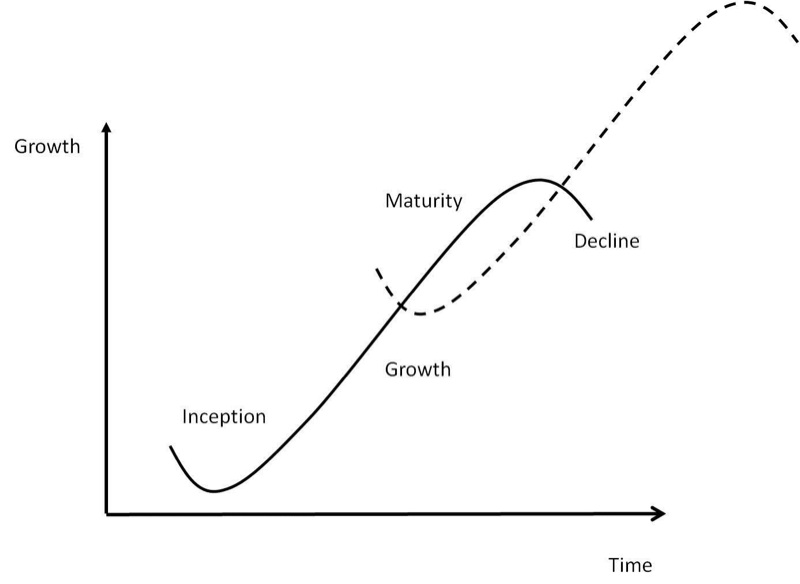Innovation is about competitive advantage, how to secure it and how to sustain it.
Many marketing driven ‘innovations’ have come and gone. Some made a huge difference, and some never lived up to the hype. For the technologists reading this, do you remember Enterprise Java Beans - possibly the most pointless technology of all time?
Innovation does not always mean inventing, there are many ways to innovate. Innovation is not limited just to products, nor is the exclusive domain of ‘boffins’ in technology. Technology is often at the forefront of driving innovation but sometimes struggles for engagement with the rest of the business, and is prone to embracing the latest shiny new tool or magic method du jour. Innovation failure is common, and trust and reputations have suffered as a result.
For this reason it’s really important to build and nurture an innovation-first culture. Innovation stems from an inclusive, ‘entwined’ organisation. Innovation needs to be a cross-cutting discipline that align company strengths, and identifies opportunities across all the disciplines of an organisation. Bringing these together means changing how we think about products and services.
Pure product innovation becomes harder and harder over time. It’s very difficult to sustain ‘winning features’ in perpetuity. Adding too many features causes confusion and lack of engagement, as does providing too few. The Kano model of customer satisfaction, describes how providing a small set of delighters in the feature set yields increased user satisfaction. However expensive and difficult to implement, delighters inevitably become baseline features over time.

We need to look beyond the pure play product increments and ‘jump the curve’, beyond product features. Avoid ‘better sameness’ at all costs, as this inevitably leads to cost differentiation and then it’s a race to the bottom.

The curve jump can also be applied to entire businesses, which can be thought of as one big product, with it’s services as features.
There is a current race to digitise, digitalise and transform existing businesses to become digital businesses. This is led by by those who see the disruption in their industries. For some companies, this digital transformation is a catch up, me-too initiative rather that a truly innovative industry-changing curve-jumping venture. It has to be done because all the others are doing it. It’s usually an attempt to offer existing business services via new channels, to better understand customers, and to automate the back-office functions.
Becoming digitally innovative is so much more than this, and demands a profound industry change. Such change is rare, and it is difficult for the most part to understand how technology can provide a brand new set of opportunities for moving from your current market position to a brand new one.
Apple's audacious ideas about the iPhone and Tablets, changed the game and set the new standards in the mobile industry. Apple was not even a part of this industry. Apple didn’t make a mediocre cell phone with an Apple logo, it was completely different, superior design and quality, won an instant following, and built on the company's provenance in user experience and interface design. No-one had seen anything like this before. Bye-bye clickety-click fiddly mechanical buttons; hello swiping, transitions, and apps!
Another current example of curve jumping is Amazon, who have now opened physical book stores. Yes, the company that disrupted the bricks and mortar book industry is now opening Amazon Books.
"I've been asked for 20 years, 'Will you guys ever open physical stores and I've answered pretty much the same way the whole time, which is that we will if we have a differentiated idea. You know it can't be a me-too offering, because the physical world is so well-served already." Jeff Bezos.
In the race to digitally transform existing businesses, how do we achieve innovation, perform a curve jump, and carve out a brand new sustainable competitive advantage? A tall order! It does not happen overnight, and to attempt to do so, taking a risk on a new unproven concept may not be prudent. The following is a list of considerations (in no particular order) that can help to get you there.
Innovation Starters
Change the status quo
Set up the game in your favour and equip yourself with the strengths and capabilities needed. Have a vivid goal, and ensure it’s the right one. Know your Why. No tunnel, vision, no blind spots.
Research
Understand current trends in technology, operations, and developments across your industry. Watch what other companies are doing, and be inspired when it's working, but don’t do what they are doing. They are likely already ahead, you need to find some other Blue Ocean to exploit!
Inclusivity, listening and coaching
Don’t set up an innovation department or an innovation team that’s responsible for the great ideas. Give responsibility to someone who manages across existing functions, and provides an innovation framework and support structure. Consult regularly, listen and advise. Provide tools and techniques, but ensure that the innovation comes up through the ranks and informs the company strategy as much as externally sourced intelligence. The wisdom of the crowds is powerful.
Iterate: build, test, measure, learn
Innovation is a process of learning, and exploration. When a niche is identified, a way to make it happen, or discover whether it’s even possible must be explored. The way to do this is to ensure actionable, high quality data and feedback are acquired. Allow teams to understand the domain and talk to other disciplines about how it might be exploited.
Don’t follow the pack, carve out your own space
If you’re doing what someone else is already doing, this isn’t innovation. Perhaps technology is being used in a different way, and perhaps the product or product mix is different, but if the end business model and strategic positioning are not, then you are only attempting to get an advantage by optimising, and building a better mousetrap. This can be copied, and doesn’t represent a sustainable advantage. If your company can encroach on an existing business model by using technology, many others can too. Before long you will have many competitors, and the only remaining course of action is price differentiation.
Fail fast and observe the pioneers
Failure will be inevitable, but it’s a central part of hypothesis testing and to ensure your status quo disrupting strategy is more than just a pipe dream. In Agile, there is a concept of a ‘spike’, which is used to validate an idea. Learn the domain, and get more information, so that execution can happen with a firm goal and better ability to make a commitment. Spikes sometime tell the team that the idea is ‘too hard’ and this changes the product thinking. Yes I want X, but not if it’s going to cost Y is a common outcome.
Pay attention to your industry to observe and learn from the mistakes and struggles of others. Exploit Late Mover Advantage.
Don’t bet the farm
This is related to the point above. Big, all promising initiatives are doomed to fail. In fact it’s easy to lose sight of the goal altogether. Keep iterations small and focused, with measurable and achievable goals. Ensure that failures provide learning, but don’t take the entire company down in an epic way. Keep iterating, keep steering towards the goal, and change the goal if the costs and benefits don’t work in your favour.
Ensure sustainability
This is a major gotcha in nearly all start-ups, even the disruptive ones. In the drive to release new features, with a overly product-centric innovation approach, divergence between customers occurs. The end result is a complex system or organisation that doesn’t scale, cannot be supported, and provides shaky foundations for future innovation. Make your technology, operations and ways of working bulletproof before pivoting toward a new idea. Always ensure the business and technology foundations are solid, and effective, or that niche will remain out of reach.
Set up for change
Ensure that new business is not being built on yesterday's assumptions about organisation, operations and delivery. Set yourself up to succeed and to give your teams what they need to be able to collaborate. It may be uncomfortable, and it may seem chaotic or not the way to do things, but that’s change. If something completely new is desired, the correct structures must be in place to support it.
Don’t create innovative junk
Technologists can often be seduced by new technologies that have no concrete business cases. Businesses can jump on fads, then try to make the rest of the organisation adopt the new technology or way of working without knowing what commercial outcome is sought. It’s easy to brainstorm, and it’s also easy to come up with bad ideas. Worst Possible Idea is an approach used in design to find out the bad ideas, and then use that output as a basis for getting to a good idea. It’s easy to have a have bad idea, and not easy to spot one, so beware! Make sure that you have a solid validation framework to find out how good an idea is, or you will end up with innovative junk.
Don’t leave it to the techies
Engineers may say otherwise, but most are pure technophiles, and not designers. Whilst technology should be applauded for often being the driving force for innovation, it is far betterto innovate across disciplines. Commercial leaders must challenge your early technology adopters by having open, business-focused discussions, where business models, competitive landscape and market opportunities have as much prominence as tech.
Don’t make the CIO the only interface to your technology organisation. Ensure that openness occurs at all levels. Have each corporate function learn about what tech does for them, and have tech reciprocate. It may sounds complex to some, but setting up a truly innovation organisation demands cross-functional understanding.
Focus on what you do best for your customers
Don’t make leaps of faith. Understand why your customers love you and find new ways to excite and engage them. This goes way beyond the digital initiatives to create apps and engaging digital experiences. It goes beyond Facebook marketing and even email campaigns are now in the ‘traditional’ realm. Truly understand your customer using data and analytics. Understand what strengths can be exploited and innovated, and lead the conversation. Share the vision with customers, and don’t merely give them what they ask for.
Businesses are becoming technology centric, and technology is becoming business centric. Let’s use our hard, factual, experimental approach and ways of working throughout our newly cross-functional teams, and create a better, more collaborative way of creating competitive advantage.
